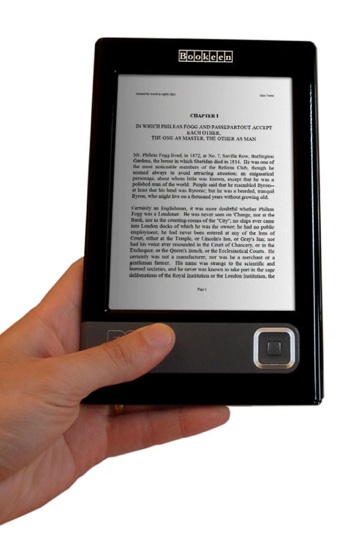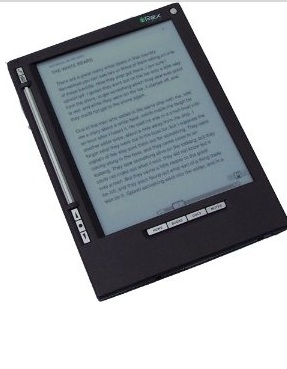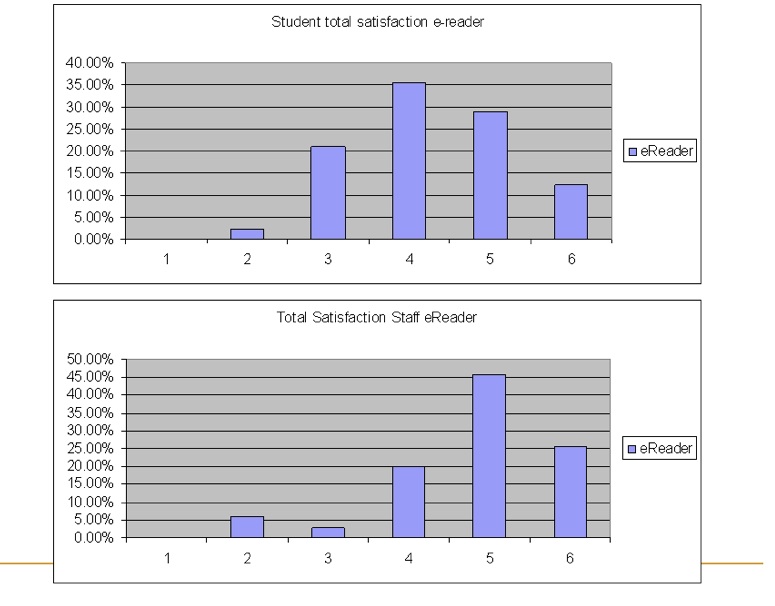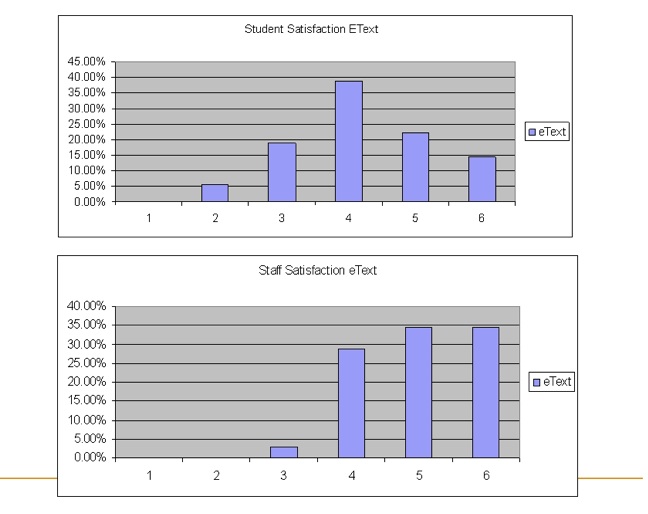The 2009 SLAV Research Grant recipients Wilma Kurvink and her team Marie Turnbull, Bart Rutherford, Margaret Pajak, Meg Moores and Cameron McIntosh, at Wesley College have just completed a study into using eReaders at school. Wilma has kindly shared an edited version of her report with readers of Bright Ideas. A fuller account will be published in SLAV’s Synergy online journal shortly.
To be published in the next edition of SynergyThis project explored the potential of e-texts and e-readers as a viable technology to maintaining the linear text as a key modality in an educational setting, and for reducing printed materials and waste.At the time of writing the research outcomes the Apple iPad was to be launched, promising a step closer to a seamless integration of e-texts into a device. By now many readers will have seen, or purchased the iPad and some of the information in the article will be outdated, and superseded. This serves to highlight how rapidly the publishing industry is changing as texts are changing into digital formats. Now it is possible to incorporate non text materials into linear text, which challenges traditional notions of material descriptions in library catalogues.While comparisons with the iPad and its promise of multiple formats, and applications in a single tablet device are tempting, it exceeds the scope of the research. Our trial was conducted on e-readers that use e-ink technology, and the various operating systems they are coupled to. iPads and related tablet technology, have a backlit screen and encompass many functions, including games, video and email. The e-ink technology, and readers we trialled were solely dedicated to the delivery and consumption of linear text.Trial summary and results overviewThe project consisted of 3 strands of inquiryA comparative study of 10 older and 21 younger readers was undertaken, examining the affective domains, and the associated experiences of reading in a new device. The devices trialled were Iliad and Cybook e-readers.The testing of models of delivery and acquisition of e-texts to a device, examining the issue of Digital Rights Management in the acquisition process. Exploration of the potential integration of e-texts into the formal catalogue and purchasing systems in the college.An investigation of how the e-Reader and e-text adoption would influence the publishers and distributers, inquiring into whether publishers and distributors would to adopt models that make purchasing and management practical for the school sector.The trial took place between April 2008 and November 2009.The research outcomes show that older readers were significantly more engaged with and accepting of the e-reader device than younger readers. The research also pointed to older readers being more established readers who viewed the e-text and e-reader combination as providing an extension of their reading. Although all younger readers were experienced readers, they related less well to the device overall, and were less inclined to continue to read with it. The research highlighted significant generational difference in the trial groups- both in relation to reading itself and how technology may impact or change it.The trials revealed significant difficulty for schools in the purchase any e-text to be transferred to a device. Major issues were identified in the current deployment of Digital Rights Management as it is embedded in many of the transactions related to purchase. In addition limited access to titles both locally and globally are affected by restrictive practices in copy right and digital rights management.The investigation demonstrated that the publishers and distributors had not considered the library sector as a significant player in the e-text expansion, and the school sector as even less so. The research also highlighted a lack of planning across the publishing sector to guarantee a technical delivery of e-text that was seamless across sectors and industry instead opting for multiple formats and delivery in a competitive environment.ConclusionsThe e-reader and e-text trial undertaken by the Wesley College Library team demonstrated that the younger readers in the trial were less satisfied with the e-text and e-reader combination that the adult readers. Adult readers spent more time reading in the trial, and were more committed to continue with an e-reader. Younger readers were more critical consumers of the technology, more inclined to experiment with then and also found less reason to read an e-reader when a hardcopy was available. This tendency became less pronounced when it came to older students who saw benefits in using an e-reader/e-text combination in preference to using hard copy text books.The implementation of e-texts combined with e-readers in a conventional library acquisition and cataloguing system is practically unworkable, mainly due to the amount of Digital Rights Management embedded not only in the acquisition and title transfer process but also in the restrictions placed by suppliers on the readers themselves and the number of devices that can be used to transfer titles to. It must be conceded that e-readers are most effective when they are personal devices which are personalised by their user. Article collections and e-book titles cannot be transferred from one e-reader to another, and over time an e-reader that belongs to a person becomes as idiosyncratic of the users interests as does their bookshelf at home, or the bookshelf and file in the office.More advantageous for school libraries and academic libraries are the options of subscribing to e-text collections and e-text libraries such as can be done with Warners, and EBL for instance. These options can be offered in existing technical systems in schools, or could become a reality for many schools via consortia purchase. Equally, involvement by state education departments in developing e-text access for text book delivery may be advantageous from many perspectives, particularly from a sustainability viewpoint and to reduce the weight of school bags for students travelling to and from school.The paper concluded that while publishers, and on sellers were still formulating models to publish and disseminate e-texts, a window of opportunity exists for libraries to reconsider their role in the mediation of e-text materials. To successfully take up the opportunity will involve cross sector collaboration to overcome digital rights management and copyright issues, as well as overcoming the technical difficulties that accompany the current modes of delivery. In addition, consortia models for e-text delivery to schools will need to be developed to ensure that school libraries can deliver access to all, regardless of the resourcing levels within individual schools. Ensuring equity for students to be at the heart of all quality library programs, and should drive this innovation.
To be published in full in the next edition of Synergy
The paper concluded that while publishers, and on sellers were still formulating models to publish and disseminate e-texts, a window of opportunity exists for libraries to reconsider their role in the mediation of e-text materials. To successfully take up the opportunity will involve cross sector collaboration to overcome digital rights management and copyright issues, as well as overcoming the technical difficulties that accompany the current modes of delivery. In addition, consortia models for e-text delivery to schools will need to be developed to ensure that school libraries can deliver access to all, regardless of the resourcing levels within individual schools. Ensuring equity for students to be at the heart of all quality library programs, and should drive this innovation.
This project explored the potential of e-texts and e-readers as a viable technology to maintaining the linear text as a key modality in an educational setting, and for reducing printed materials and waste.
At the time of writing the research outcomes the Apple iPad was to be launched, promising a step closer to a seamless integration of e-texts into a device. By now many readers will have seen, or purchased the iPad and some of the information in the article will be outdated, and superseded. This serves to highlight how rapidly the publishing industry is changing as texts are changing into digital formats. Now it is possible to incorporate non text materials into linear text, which challenges traditional notions of material descriptions in library catalogues.
While comparisons with the iPad and its promise of multiple formats, and applications in a single tablet device are tempting, it exceeds the scope of the research. Our trial was conducted on e-readers that use e-ink technology, and the various operating systems they are coupled to. iPads and related tablet technology, have a backlit screen and encompass many functions, including games, video and email. The e-ink technology, and readers we trialled were solely dedicated to the delivery and consumption of linear text.
Trial summary and results overview
The project consisted of 3 strands of inquiry
A comparative study of 10 older and 21 younger readers was undertaken, examining the affective domains, and the associated experiences of reading in a new device. The devices trialled were Iliad and Cybook e-readers.
The testing of models of delivery and acquisition of e-texts to a device, examining the issue of Digital Rights Management in the acquisition process. Exploration of the potential integration of e-texts into the formal catalogue and purchasing systems in the college.
An investigation of how the e-Reader and e-text adoption would influence the publishers and distributers, inquiring into whether publishers and distributors would to adopt models that make purchasing and management practical for the school sector.
The trial took place between April 2008 and November 2009.
The research outcomes show that older readers were significantly more engaged with and accepting of the e-reader device than younger readers. The research also pointed to older readers being more established readers who viewed the e-text and e-reader combination as providing an extension of their reading. Although all younger readers were experienced readers, they related less well to the device overall, and were less inclined to continue to read with it. The research highlighted significant generational difference in the trial groups- both in relation to reading itself and how technology may impact or change it.
The trials revealed significant difficulty for schools in the purchase any e-text to be transferred to a device. Major issues were identified in the current deployment of Digital Rights Management as it is embedded in many of the transactions related to purchase. In addition limited access to titles both locally and globally are affected by restrictive practices in copy right and digital rights management.
The investigation demonstrated that the publishers and distributors had not considered the library sector as a significant player in the e-text expansion, and the school sector as even less so. The research also highlighted a lack of planning across the publishing sector to guarantee a technical delivery of e-text that was seamless across sectors and industry instead opting for multiple formats and delivery in a competitive environment.
Conclusions
The e-reader and e-text trial undertaken by the Wesley College Library team demonstrated that the younger readers in the trial were less satisfied with the e-text and e-reader combination that the adult readers. Adult readers spent more time reading in the trial, and were more committed to continue with an e-reader. Younger readers were more critical consumers of the technology, more inclined to experiment with then and also found less reason to read an e-reader when a hardcopy was available. This tendency became less pronounced when it came to older students who saw benefits in using an e-reader/e-text combination in preference to using hard copy text books.
6 rated as excellent, 5 rated as very good, 4as good, 3 as acceptable, 2 as poor and 1 as very poor
The implementation of e-texts combined with e-readers in a conventional library acquisition and cataloguing system is practically unworkable, mainly due to the amount of Digital Rights Management embedded not only in the acquisition and title transfer process but also in the restrictions placed by suppliers on the readers themselves and the number of devices that can be used to transfer titles to. It must be conceded that e-readers are most effective when they are personal devices which are personalised by their user. Article collections and e-book titles cannot be transferred from one e-reader to another, and over time an e-reader that belongs to a person becomes as idiosyncratic of the users interests as does their bookshelf at home, or the bookshelf and file in the office.
6 rated as excellent, 5 rated as very good, 4 as good, 3 as acceptable, 2 as poor and 1 as very poor
More advantageous for school libraries and academic libraries are the options of subscribing to e-text collections and e-text libraries such as can be done with Warners, and EBL for instance. These options can be offered in existing technical systems in schools, or could become a reality for many schools via consortia purchase. Equally, involvement by state education departments in developing e-text access for text book delivery may be advantageous from many perspectives, particularly from a sustainability viewpoint and to reduce the weight of school bags for students travelling to and from school.
Thanks to Wilma and her team for undertaking and sharing this valuable research. A reminder that the full account of the research will be published in the next online edition of Synergy. A reminder to SLAV members that if you have mislaid your Synergy login details, please contact the SLAV office for assistance.





Pingback: Tweets that mention Wesley College investigates eReaders | Bright ideas -- Topsy.com
Congratulations Wilma and the Wesley team and SLAV research grants for a very timely article – and thank you Judith for the email drawing attention to it. This confirms the concerns contributed to the edna webinar eBook discussion last Thursday regarding eBook access and management, facilitated by Kerrie Smith. It also gives us very interesting insights into student perceptions to take to discussions with teachers at our schools.
Pingback: It’s only words, and words are all I have… « Reading Power
This is really timely information for me, thank you for posting it. I am working on an iPad pilot program for the next school year and have been collecting as much data and research as I can find on 1-to-1 learning and eReaders. Very interesting findings!
Very timely research. Has anyone tried the KOBO e-reader available from Borders and Angus & Robertson?
Pingback: Poor key to population « READINGPOWER
Pingback: Exploring eBooks, eReaders and Libraries Extras « Reference & Information Services
I personally think ereaders will replace libraries eventually. Of couse, I personally love the nostalgic feel of a REAL book in my hands, and also actually feeling like I OWN the book. Of course, I still use vinyl records and insist analog is where its at! Call me old school!